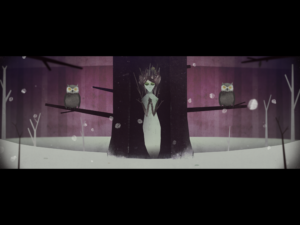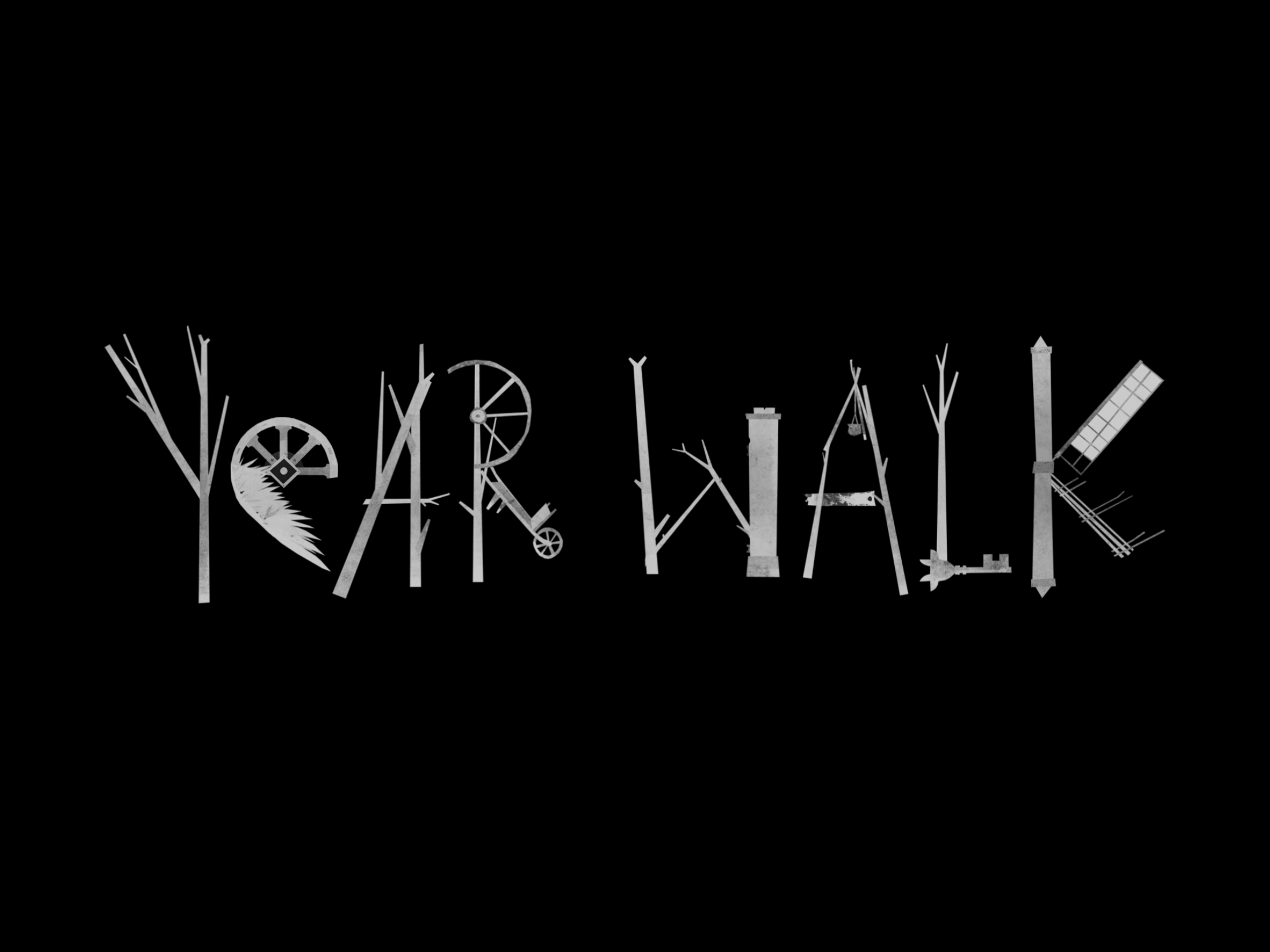Basic information
Name: Year Walk
Creator: Simogo
Platform: I played the game on an iPad.
Target audience: People who enjoy games involving puzzles, exploration, and supernatural / horror elements.
Formal elements
Players: Single player. This ties into the game experience, as the narrative involves a man trying to glimpse his future by braving the wilderness alone in a mystical tradition.
Objectives: Completing the puzzles and uncovering the player character’s future.
Rules & procedures: The player explores the area by panning his field of vision left and right. At certain locations, he can move forwards and backwards to traverse the game space. Puzzles and clues are scattered throughout the landscape. Puzzles accept valid interactions, and only grant clues / game progression when given specific inputs. Entering certain locations at specific times trigger cutscenes.

Arrows indicate the possibility of moving forwards and backwards.
Resources: To solve the puzzles, the player must note and interpret clues. Solving the puzzles are necessary to progress in the game.
Boundaries: The player character traverses a bounded game space. He can only move along the map by panning left and right, or moving forwards and backwards at certain locations (indicated by up and down arrows). He cannot move off the map. Portions of the map can be unlocked only by solving certain puzzles.
Outcomes: As this game is explorative, players cannot really “lose” unless they give up. Thus, the only outcomes are completing the game (solving all required puzzles) and discovering the ending, or not completing the game.
Types of fun
Year Walk features the aesthetics of challenge, discovery, and narrative.
Challenge: This game delivers the aesthetic of challenge well. It features a diverse range of puzzles, which must be solved by memorization, following trails, interpreting the tone of sounds, and more. This variety keeps the player engaged.
Discovery: I have mixed feelings about this aesthetic. On the one hand, the map is beautifully designed, and the limited range of view and movement amplifies the mysterious feeling the game evokes. For those who like puzzles, horror elements, and the supernatural, intentional features of the game (eerie soundtrack, grotesque figures, clues scratched on trees and on gravestones) can also fuel the urge to explore the game world. That said, because there is no mini-map, players can find it unnecessarily difficult to retrace their steps or revisit certain locations, leading to frustration and detracting from the experience.
Narrative: Again, I have mixed feelings about this aesthetic. The game delivers a simple narrative delivered through cutscenes and silent text frames. The eerie, foreboding atmosphere of the game suggests that something bad will happen, which can cause the player to want to uncover the protagonist’s fate. For example, the doll that turns bloody hints at impending death, as does Stina’s comment that something bad happened to her cousin during his / her Year Walk.
However, I felt that the narrative is not as immersive as it could be. For one, I wanted to know more about the protagonist and his motivations. Players know that the protagonist wants to learn his future, and the narrative hints that he might have / be planning to propose to Stina. That said, I would have liked some more information about the protagonist to feel more attached to him and to root for his success.

Stina, the protagonist’s disapproving love interest.
More significantly, I felt that many of the symbols / artifacts in the game (e.g. the dryad, engravings) hold particular cultural significance. But aside from Googling it, I had no way of knowing what they were. It’s a shame that the game doesn’t try to enhance the narrative by educating the player about these.

I assume that this dryad lady has some sort of cultural significance. What it is, I have no idea.
Moments of particular success or epic fails
Successes: After winding up the bloody doll and listening to the song 3 times, I finally realized its connection to the dryad tree with the 2 perched owls. Solving that puzzle gave me a boost of confidence and made me feel great.

The creepy doll and the owls.
Fails: At the beginning of the game, I stared at the still scene with a house for 2 minutes straight before realizing that it wasn’t a cutscene, and that I was expected to pan the screen to explore the map. This made me feel quite stupid. Also, I spent an abysmal amount of time trying to revisit past locations.

The starting point of the game. I was stuck here for the longest time.
Things I would change to make the game better
Add a mini-map: While this may detract from the enacted narrative of being lost in the woods, I feel that this tradeoff is worth it because trying to retrace my steps and revisit past locations was extremely frustrating. As long as players do not have the ability to fast-travel, I think the current mechanics for traversing the map will preserve the game’s intended atmosphere.
Add visual aids: Players might not know that traversing the map involves panning, zooming in, and zooming out. I would fix this problem with more visual cues, such as pop-up instructions or blinking arrows.
Allow players to revisit clues: While part of the game’s fun comes from noting and interpreting clues, it can be frustrating to figure out a clue, then having to revisit a particular location because you forgot. I’d fix this problem by creating a journal page that automatically documents clues the player has uncovered.
Enhance the narrative: As previously mentioned, I’d appreciate it if the game elaborates a bit more about the protagonist’s backstory / motivations, as well as the cultural significance of in-game artifacts and symbols.



